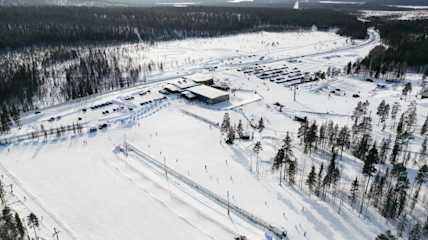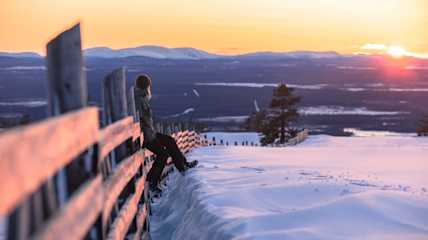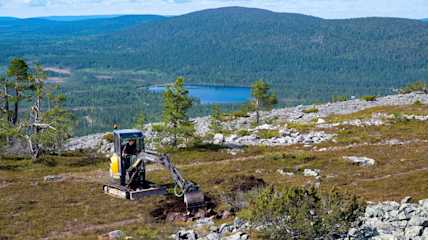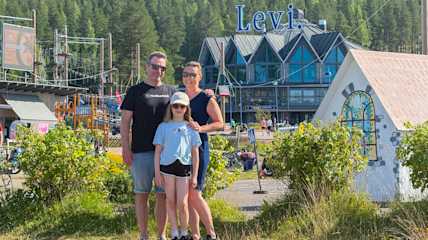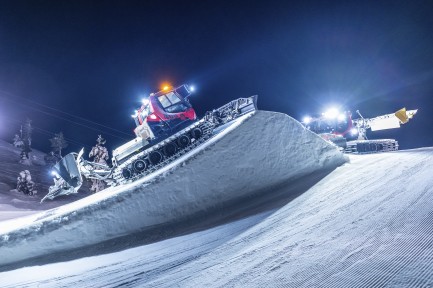
Efficienct of fell operations with machinery and skilled drivers
When the lifts close in the evening, the nighttime operation of slope machines begins. Six slope machines depart from Levi South Slopes Service Point. During the evening and night, two PistenBully 400 machines maintain the South Slopes' parking areas, other slopes are maintained by PistenBully 600 machines.
The weight of a slope machine is approximately 12,000 kilograms, and the crusher width of the slope machine is 6.4 meters. PistenBully 400 machines feature dual-lever joystick steering, while PistenBully 600 machines feature wheel steering. The slope machines have a throttle but no separate brake pedal; braking is done by lifting the foot off the throttle, causing the slope machine to stop immediately.
VERSATILE SLOPE EQUIPMENT
In addition to the slope machines in operation every night, Levi's Service Point also has two spare PistenBully 600 machines. Furthermore, the facility houses a PistenBully 300 crane machine used for high-altitude work such as maintaining slope lights, lift roller tracks, and, if necessary, in rescue situations. The PistenBully 300 can be fitted with summer tracks, allowing maintenance operations even in snow-free periods. The winch machine weighs approximately 15,500 kilograms.
Out of Levi's eight slope machines, three are winch machines used in the steepest areas of the mountain, such as the G.2 slope, during snowmaking on the W.2 and W.3 slopes, on the 6.2 slope, and on the 13.3 slope. The first PistenBully slope machine was put into operation in Levi in the 1980s. Currently, the youngest slope machine operator is 18 years old, while the oldest is 60.

Slope Manager Jani Hämäläinen took on the role of slope machine supervisor at Levi Ski Resort in December 2023. Before this, Jani worked as a lift operator, in lift maintenance, and in machinery. In addition to his supervisor role, Jani operates slope machines and maintains and repairs them.
- One slope machine covers about 80 kilometers of travel during the night, and it takes approximately 9 hours to groom the slopes, although this may vary depending on weather conditions. The optimal driving speed for slope machines is 11-12 km/h, making the operation cost-effective. In the morning, we also perform additional grooming on the uphill slopes if, for example, there has been strong winds overnight, causing unevenness on the slopes, clarifies Jani.
LEVI SKI RESORT TRANSITIONS TO RENEWABLE FUEL FOR SLOPE, TRAIL AND TRACK MACHINERY
Our entire fleet consists of the latest and most energy-efficient technology. In terms of the ski resort's energy consumption, fuel for the machines plays a significant role. The fuel consumption of slope, trail, and track machines accounts for approximately 25% of the total energy consumption.
Wanting to consider environmental aspects, we switched to using renewable fuel for slope, trail, and track machines in the 2023-2024 season. This reduces the carbon footprint of slope, trail, and track machines by an estimated minimum of 70%. By transitioning from fossil fuels to renewable fuel, we were also able to reduce emissions from fuel production.
- We invest in training our staff for more economical driving practices and monitor fuel consumption on a machine-specific basis. The latest training was provided by an expert from PistenBully's factory who visited Levi in winter 2023-2024. The training covered topics such as optimal settings for slope machines in different weather conditions, aiming to reduce fuel consumption, explains Jani Hämäläinen.
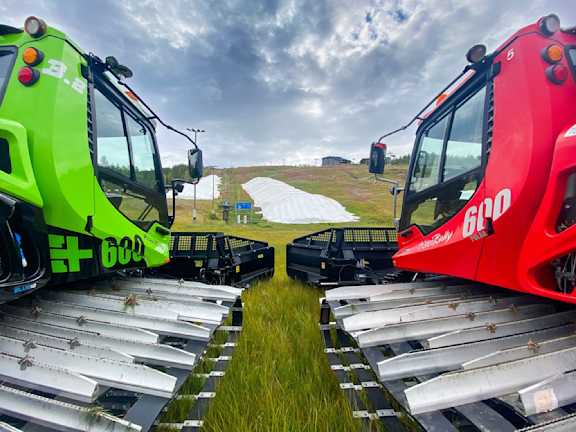
All of our slope machines are equipped with the SnowSat system, which measures snow depth. In addition to measuring snow depth, the system tracks fuel consumption, operating hours, hectare count on the slopes, and slope-specific snow volume throughout the winter. By measuring snow depth, we can better plan and optimize snowmaking and machine operations.
The goal is to always produce the right amount of snow in the right place, which is why successful collaboration between machine operators and snowmaking staff is essential.
- It's important to know how much snow is needed on the slope, so that there is neither too much nor too little. For example, 60-90 cm of snow is sufficient on the South Slopes, while the West and Front Slopes of Levi require 1.5 meters of snow to withstand skiing and machine grooming throughout the winter, says Jani.

LEVI'S SKI TRAILS ARE GROOMED DAILY
Levi Ski Resort's trail and track machines play an essential role in ensuring smooth and safe skiing throughout the ski season. We have three PistenBully 100 SCR trail machines that groom the trails daily. These machines are slightly smaller than slope machines, each weighing 8.5 tons. These machines also use renewable fuel, reducing the ski resort's environmental impact.
One trail machine covers approximately 100 kilometers per day when all trails are open. During the winter season, each machine accumulates about 1000 hours of operation. The operating speed of the machine varies depending on the weather, but under good conditions, it is approximately 15 km/h.
The trail machines start work during peak seasons at 6 a.m. and at 7 a.m. during other times. Levi's trails are groomed in both directions daily, as the trail width is 4.5-5 meters, while the machine's track width is 3.40 meters.
Skiers react differently when they see trail machines.
- Skiers don't need to panic or be afraid when they see a trail machine. Trail machine operators do not drive over anyone. When you see a trail machine, it's good to move aside to the free side where the machine is not grooming. You can ski on the trail at the same time as the machine. Some skiers try to follow the machine, but the trail machine maintains a steady speed throughout, even on uphill sections, so skiers following behind often lag behind, says Trail Supervisor Jouko Majava.
In early winter, we often receive many questions about why more trails haven't been opened.
- One significant factor is that trail machines can only operate on ice approximately 40 cm thick. This means that the ice on lakes and other water bodies must be thick enough for the machines to safely cross. Every winter, we have to make several crossings over water bodies on the trails. Large lakes and swampy areas are particularly challenging. Fortunately, the skill of the drivers helps, and they scout the routes for the trails and tracks before starting actual trail work. A lot of groundwork is done before the trails are opened, and this groundwork is done using snowmobiles. River crossings are frozen using pumps, and large lakes are crossed using snowmobiles. With these measures, we ensure the safe and early opening of the trails for our customers, says Majava.
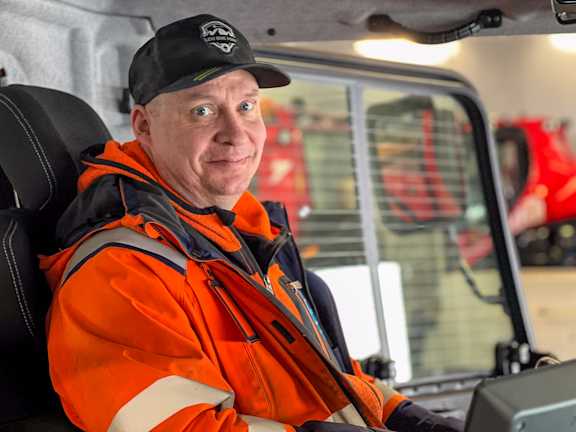
Jouko Majava primarily maintains snowmobile trails.
MAINTENANCE OF KITTILÄ'S SNOWMOBILE TRAILS
We have two Bisten Bully 1004F track machines with larger engines than the trail machines, making them more powerful and heavier. These machines have an operating speed of about 15 km/h, although the speed depends on the condition of the trail.
Renewable fuel is also used in snowmobile trail machines. The machines are equipped with a blade designed and made by Levi Ski Resort, ensuring optimal results in trail maintenance.
Snowmobile trails are groomed daily with two machines. One machine focuses on maintaining local trails, while the other handles longer routes, such as the Levi-Pulju-Pokka loop, covering 240 kilometers. The length of a day's work per trail machine ranges from 80 to 150 kilometers. Altogether, there are nearly 900 kilometers of snowmobile trails in the Kittilä and Levi area.
- Snowmobile trail grooming ends at the end of April, as crossings over water bodies and marshy areas pose a risk of sinking as spring approaches, says Jouko Majava.
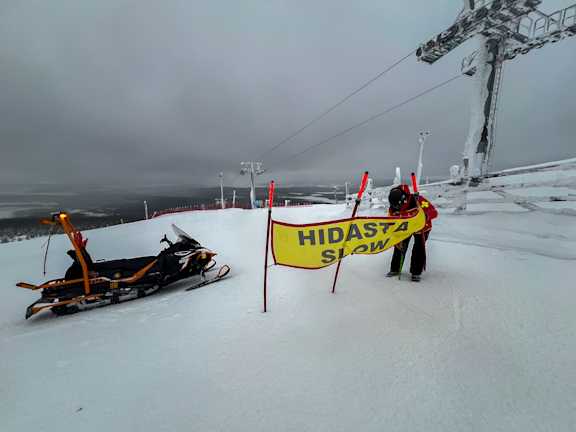
SNOWMOBILES BEHIND WINTER OPERATIONS
Snowmobiles play a central role in our winter operations at Levi Ski Resort. We have 35 snowmobiles that serve in various tasks in our snowy environment. All our snowmobiles are new four-stroke models, which are both energy-efficient and environmentally friendly. Electric snowmobiles have already been tested for work use at the center.
Snowmobiles are actively used during snowmaking, as important tools in lift monitoring, lift maintenance and inspections, Ski Patrol operations, and as emergency medical service snowmobiles. On the trail side, snowmobiles maintain winter walking and biking trails and assist, if necessary, with tasks such as supporting trail machines.
During the winter season, snowmobiles cover approximately 100,000 kilometers, reflecting their active and essential role in our operations. Joonas Larmala is responsible for the use and maintenance of snowmobiles.
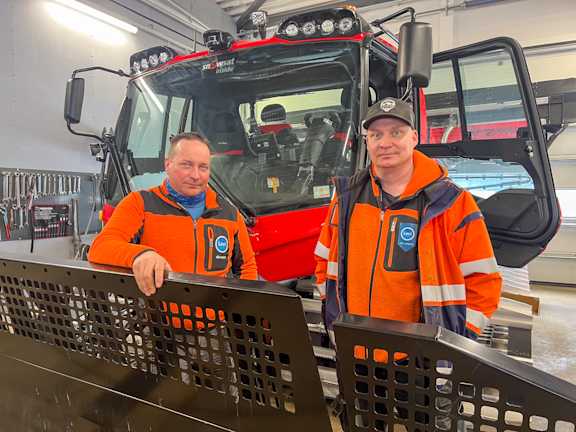
SLOPE AND MAINTENANCE OPERATIONS BUSIEST IN EARLY WINTER
Although Levi's winter season starts at the beginning of October, the equipment is in use as early as September. Stored snow piles around the fell are opened and spread out. Slopes are opened as soon as there is enough snow on them. Once opened, the slopes are groomed daily, so from September to mid-December, there is a lot happening on the slopes all the time, ensuring we can provide our guests with versatile and good slopes as quickly as possible.
- Colleagues are the most important thing in doing this work. We work with a small, skilled, and close-knit team, summarizes Jouko Majava.
